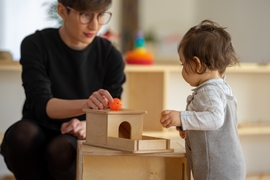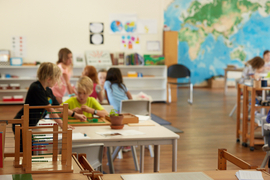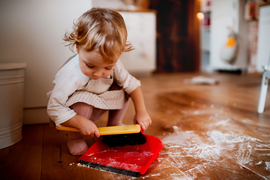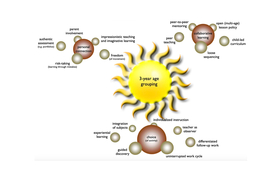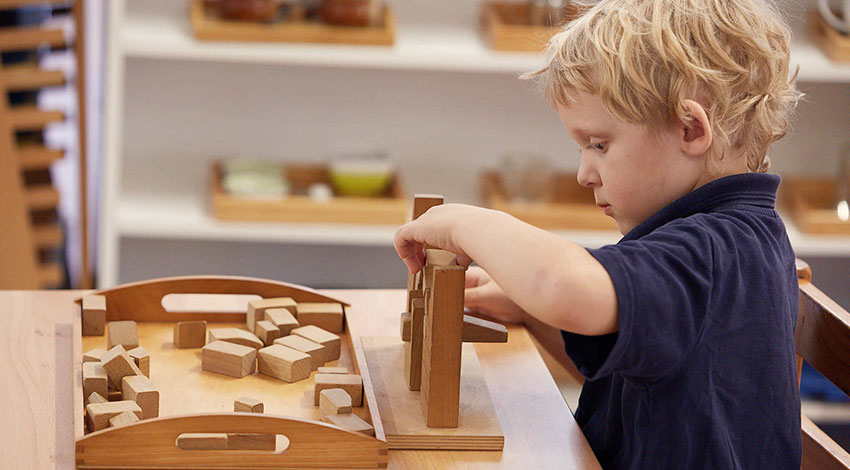
The Montessori environment prepared for preschool children from three to six years of age is called the Children’s House. The Children’s House is prepared to be homelike, welcoming, aesthetically pleasing and orderly so children come to think of the setting as a ‘mini-community’ where they learn skills they can apply at home and in the wider community. Cooperation, rather than competition, is encouraged.
The ordered Children’s House environment provides children with structure and predictability, and helps them orient themselves both to the physical environment of the Children’s House and to the multi-age ‘mini-community’ within the environment. There is a strong emphasis on children developing the independence, cooperation and skills for daily living that enable each one to become a valued and independent member of the Children’s House community. The resources and activities in the Children’s House are designed to:
- develop coordination of movement
- develop independence
- develop the ability to make informed decisions
- lengthen the amount of time a child can engage in deep concentration
- refine the use of the senses
- encourage exploration
- build social skills
- develop oral communication skills
- develop written communication and the foundations of joyful reading
- develop an understanding of mathematical concepts
The materials in the Children’s House are displayed on open shelves, always accessible to the children. The children work with these materials during work sessions that are ideally a minimum of three hours in duration with no fixed breaks. In this way children are able to develop and follow their own natural rhythm of activity and rest without unnecessary interruptions.
The prepared environment of the Children’s House incorporates indoor and outdoor spaces. Both spaces complement each other and are available to the children at all times. The majority of Montessori educational materials are commonly displayed in the indoor environment but their use is not restricted to the indoor environment. Practical life activities are part of both the indoor and outdoor environments. Children may also choose to work with materials in the sensorial, mathematics or language areas in the outside environment as long as they are using the materials for the educational purpose for which they have been designed. In addition the outdoor environment includes gardens (both wild and planted), which children care for, and in which they develop a growing awareness of the importance of the natural environment to the well-being of all living things. Activities in the outdoor environment of the Children’s House develop in children an appreciation of the natural world and an awareness of its importance to the wellbeing of all living things including themselves, as well as a beginning understanding of the important role of human beings in caring for the natural environment.
For this age group lessons are usually given to individual children. Once children have been given a lesson, the activity is added to their repertoire of possible activities and they are free to choose that activity whenever they wish. Small group activities include games used to extend earlier lessons, and language games. Children are invited to join group activities, but are not required to participate. In a mixed age group, older children can validate their learning by becoming the ‘experts’ in the room. Peer teaching occurs when the older children share their knowledge and skills, take on the role of the caretakers of the classroom and provide role models for younger children. Younger children find a group of willing people ready to help them when help is required. They are also further inspired and motivated to learn as they see older children working on the next step in the progression of lessons.
Freedom of choice is a central feature of the Children’s House environment. Children learn that free choice carries with it responsibilities and consequences, understandings that become increasingly important as they move through the later school years towards adult life.
There is a strong emphasis in the Children’s House on the development of independence, cooperation and the skills for daily life that will enable each individual to become a valued and autonomous member of his or her community. For example, in the practical life area of the Children’s House, children can choose from activities such as preparing snacks for themselves and others, laying and clearing the table, and cleaning up. They learn, under strict adult supervision, to use child-sized tools, including knives and glassware, safely and effectively. In the sensorial area children fine-tune perception, discrimination and judgement. In the language and mathematics areas children are introduced to literacy and numeracy skills. As they work through the language activities, children extend emergent and beginning literacy skills leading to fluency in both writing and reading. Mathematics activities lead children from early counting and matching experiences towards increasing understanding of number patterns, the four operations, number facts and two- and three-dimensional shapes. In general teacher/child ratios are carefully planned in the Children’s House so there is just enough support for the children, but not too much interference from adults in the children’s activity. Children are encouraged to be self-reliant, or to solve problems with their peers with as little adult intervention as possible. In this way children develop self-assurance and self-esteem.
Incorporated into the four areas of the Children’s House curriculum are materials, activities and exercises that introduce children to visual arts, music, physical education, science, geography and history. Montessori educators sometimes say that the Children’s House is designed to bring the world to the child. For example, in the Children’s House children listen to stories and learn songs and dances from their own country and around the world, while participating in related visual arts activities. They also work with globes, maps, land and water forms, and collections of pictures of life in different cultures. Cultural studies of this type are interspersed within the four main areas of the Children’s House, particularly within the sensorial and language areas.
